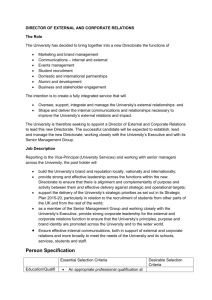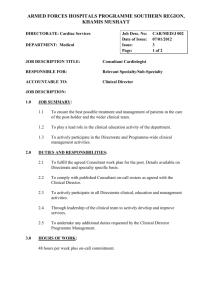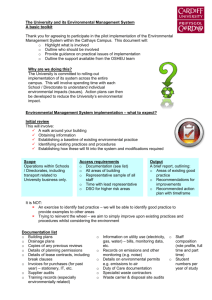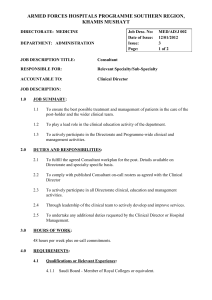Second Meeting of the Forum on Tax Administration, 1-2
advertisement
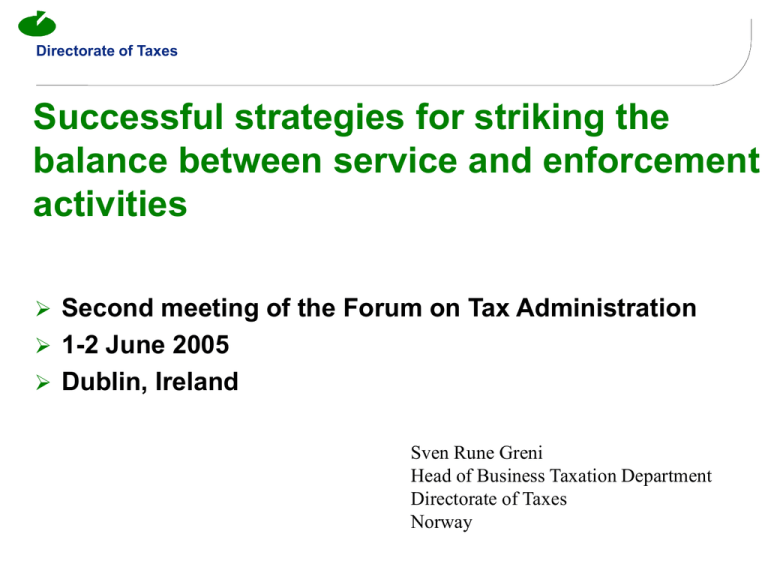
Directorate of Taxes Successful strategies for striking the balance between service and enforcement activities Second meeting of the Forum on Tax Administration 1-2 June 2005 Dublin, Ireland Sven Rune Greni Head of Business Taxation Department Directorate of Taxes Norway Directorate of Taxes Service and enforcement - Competing strategies? The ”political”/external perspective User-oriented tax administration The internal perspective Improved service = improved compliance The resource perspective Conclusion: Both strategies have to be adressed the challenge is to find a good balance between them Directorate of Taxes Compliance We will improve compliance, by Making it easy for the loyal taxpayers to comply Avoiding to make the loyal taxpayers disloyal Making it difficult to remain disloyal Having emphasis on defeating tax crime Directorate of Taxes Our strategic approach to improve compliance Main strategies of the Norwegian Tax Administration 2005– 2008 We shall make it easy to do things right We shall defeat black economy and tax crime We shall cooperate actively with others Directorate of Taxes Our challenge - and our strategy . . Enforcement Service ?? Directorate of Taxes Our business model - general features The assessment is based on information from the taxpayer and third party information Legal requirement to inform Tax Authority Most taxpayers comply voluntarily Segmentation and selection based on risk analysis Sample control Three main categories of taxpayers 1) employees (wage earners) 2) self-employed and companies 3) tax criminals (underground economy) Directorate of Taxes Production - ”The green and red course” Taxpayer information 3rd party information Control Production Assessment Revenue Directorate of Taxes Our business model for employees Pre-populated tax return Based on third party information Covering the most important tax relevant information Tailor-made tax return from 1999 Internet reporting from 1999 - improved in 2005 Examined and accepted/corrected by the taxpayer Planned new regime: ”Silent acceptance” Automatic controls (filters) in the production system Conclusion: Most of the tax returns follow the ”green course” Directorate of Taxes Our business model - business area segmentation Segmentation based on compliance risk assessment Influenced by whether tax professionals have assisted the taxpayer (accountants, auditors, advisors) A targeted part of tax returns follow the ”red course” Transfer of resources from the employees area No strategic segmentation between self-employed and companies Specific segments Large enterprises Petroleum companies Foreign taxpayers Directorate of Taxes Electronic services Electronic tax information on internet Rules, forms, etc. Electronic reporting - extensive use of internet Our strategy is to use the Altinn-portal Altinn is the common government internet portal of Norway, developed by the Tax Administration, Statistics Norway and the national Register Center Directorate of Taxes Electronic reporting - tax returns 80 70 60 50 2004 40 2005 30 20 10 0 Employees Business VAT Directorate of Taxes Enforcement - tax crime Make disloyal taxpayers loyal Avoid to make loyal taxpayers disloyal To maintain/increase the legitimacy of the tax system and the tax administration Directorate of Taxes Enforcement - tax crime Establishment of 5 tax crime units Cooperation with Police & Prosecution authorities Forum on economic crime Cooperation since 1993 between Confederation of Norwegian Business and Industry, Norwegian Labour Union, Norwegian Association of Rural Municipalities Tax Administration Cooperation with building & construction industry The Serious Business-project Established a separate information unit Tax information about subcontractors Directorate of Taxes Conclusion: Better balance reached! Enforcement Service

